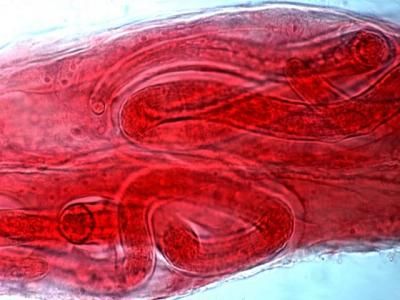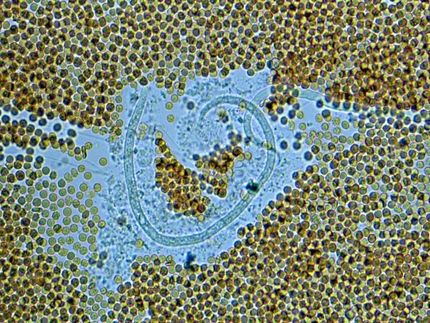Small compounds shared by all worms may lead to parasite treatment
Worms are important decomposers in soil and are great for fishing, but in humans, the slimy wrigglers spell trouble. Hookworms, whipworms, Ascaris, Guinea worms and trichina worms are just a few parasitic nematodes that infect some 2 billion people.
Now, researchers have discovered a class of small molecules that all nematodes use to signal such processes as growing, developing, mating and moving toward or away from an area. The finding could lead to prevention and treatments for worm parasites that widely infect humans, animals and crops.
"All of these nematodes speak the same chemical language," through the use of compounds called ascarosides, said study co-author Frank Schroeder, a research scientist at the Boyce Thompson Institute (BTI) for Plant Research and adjunct assistant professor in Cornell's Department of Chemistry and Chemical Biology.
The study, published in the journal Current Biology, was led by Stephan von Reuss, a postdoctoral associate in Schroeder's lab, and Andrea Choe, a postdoctoral scholar in the lab of co-author Paul Sternberg, a biologist at the California Institute of Technology.
Since nematodes are the only known organisms to use ascarosides, "we don't have to be afraid of interfering with similar biochemistry in animals, plants or humans," Schroeder said, as researchers seek to identify species-specific ascaroside molecules that may enable novel approaches to deter or disrupt the survival or reproduction of parasitic worms.
Researchers in Schroeder's lab have already filed for three patents, one that covers the structures of various ascarosides, one that covers ascarosides for use as agents to protect plants, and one that makes claims to how to use the compounds to treat or prevent human disease.
The researchers first discovered ascarosides as a signaling molecule in C. elegans, a nematode used as a model organism to study cell, developmental and nervous system biology, as well as human aging and diabetes.
"We then thought, if C. elegans uses this chemical language, perhaps other nematodes do too," Schroeder said. Proving their hunch, the researchers found ascarosides in the secretions of every nematode they examined, and a few subsequent experiments showed that the small compounds also acted as signaling molecules in the species' they investigated.
The ascaroside communication system in nematodes resembles communication modes in bacteria where very different bacteria species can communicate using a conserved chemical code, Schroeder said.
Most read news
Other news from the department science

Get the life science industry in your inbox
By submitting this form you agree that LUMITOS AG will send you the newsletter(s) selected above by email. Your data will not be passed on to third parties. Your data will be stored and processed in accordance with our data protection regulations. LUMITOS may contact you by email for the purpose of advertising or market and opinion surveys. You can revoke your consent at any time without giving reasons to LUMITOS AG, Ernst-Augustin-Str. 2, 12489 Berlin, Germany or by e-mail at revoke@lumitos.com with effect for the future. In addition, each email contains a link to unsubscribe from the corresponding newsletter.



















































